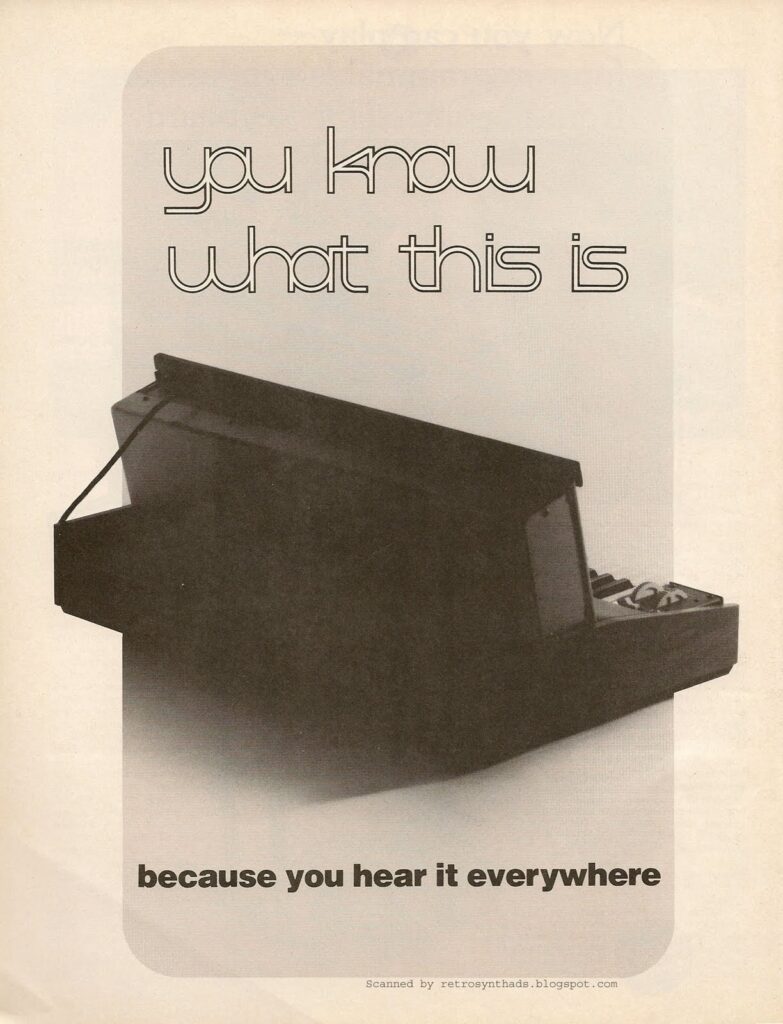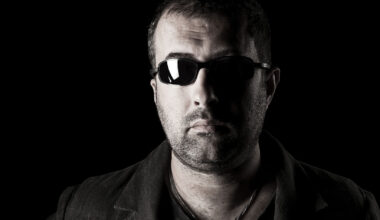Ah, the far off days of tempting magazine adverts selling new-fangled synthesisers. We take a trip through some of the very best. They don’t make ’em like this anymore… which is probably just as well
Moog Minimoog
“You know what this is” (1979)

By the late 1970s, Moog advertisements were commonplace in Contemporary Keyboard and other magazines, but they often were very corporate in their approach. Like the other big synthesiser companies of the time, Moog’s ads would fall into a few standard categories – from straight up “title/features of synth/photo of synth” ads to musician endorsements featuring Chick Corea and Herbie Hancock.
Then in July 1979, it seemed that Moog realised just how special the Minimoog had become to musicians. The ad department got to work and the result was this iconic advertisement that broke all the rules. There was no logo, musicians instinctively recognised the unique shape of the Minimoog (and if you didn’t, you were left in no doubt that you should) and no contact information, musicians knew where to get it. They had probably drooled over it in their favourite keyboard shop many times by now. There was no over-the-top marketing speak, musicians knew exactly what this machine could do, it didn’t require any hype.
This Minimoog ad is as rare as it is unique, running only once or twice before being replaced with only a slightly less cryptic colour version that actually showed the face of the synthesiser. Overkill in my opinion.
Roland SH-5
“Groupies aren’t everything” (1978)

Okay, technically this isn’t just a “synthesiser” ad. But Roland was, and still is, one of the kings when it comes to synths. And this ad does prominently feature an SH-5. It also prominently features a shiny high-waisted fashion sense one can find almost 40 years later draped on a 14-year-old walking out of an American Apparel.
The advertisement was actually created by Roland’s European distributor, Brodr Jorgensen (BJ). Within two years of placing the ad in International Musician and Recording World Magazine, BJ went bankrupt and Roland lost the supplier for one third of their business worldwide. Liquidators had quickly swooped in and taken control of over a million pounds of Roland gear. Ouch. Not only did Roland have to scramble to find a bank willing to give them a line of credit before they tanked, but they also feared that the liquidators would flood the market with cheap Roland gear before they could buy it back and undercut their own sales.
But, as we all know, Roland survived and went on to produce some of the most iconic synthesisers and drum machines in the business. Close call. For the first time ever I hope a bank president got a bonus at Christmas.
Dataton 3301 Polyphonic Computer
“Here it is housewives…” (1979)

The Dataton 3301 Polyphonic Computer was part of a larger system that included the 3000 modular synthesiser and light/projector control system. There were a number of other pieces planned as well, including controllers, dissolvers and printer units. But alas, it seems Dataton went in a different direction as a company.
Now, before we get to the obvious, I’d like to point out that this Swedish company is still alive today, and has been since 1973. Dataton may not have made it as a synth/music company, but they must be doing something right. With that in mind, what would make a marketing department create such an ad? Good question, and, well, it turns out there was no marketing department. No surprise there.
According to then-Dataton president Bjorn Sandlund, he worked on the ad with a chap by the name of Patrick Fitzpatrick who apparently knew “exactly the style [musicians] expect from an ad”. Fitzpatrick must have been a good talker because not only did he convince Bjorn to go with the “housewife” concept, but he convinced his own girlfriend to play the role.
E-mu Emulator
“Any sufficiently advanced technology…” (1982)

This was one gorgeous advertisement that first appeared in Keyboard Magazine at the beginning of 1982. And, like the E-mu sampler itself, it is pure beauty.
I can’t help but think that many synthesiser and tech geeks from the early 1980s were also heavy science fiction readers. And sci-fi nuts would instantly recognise these words first written by Arthur C. Clarke in 1973, the third of Clarke’s three laws of prediction, and E-mu hit the nail on the head when they decided to use those exact words to headline this advertisement for their Emulator sampler.
Clarke has several links to the world of synthesisers. One of his good friends and fellow science fiction authors, John Pierce, was a big wig in the world of computer music research. It was Clarke’s visit to Piece’s lab during a demonstration of a vocoder synthesiser in the early 60s that led to its use in the climactic scene of ‘2001: A Space Odyssey’. Also, during an Arthur C. Clarke lecture series speech in 1982 – the same year this advertisement came out – Piece mentioned co-worker John Chowning, then director of the Stanford University’s Center for Computer Research in Music and Acoustics. You might recognise Chowning as the electronic musician who is credited with INVENTING FM synthesis. Yes, that FM synthesis.
Unfortunately all that history didn’t come into play when E-mu marketing manager Marco Alpert used the quote – without permission I should add. He was just a fan. And it fitted. Perfectly.
Sequential Circuits Inc. Prophet-5
“Beware of false prophets” (1979)

What’s better than a full-page synth advertisement? A two-page centrefold of course. Sequential Circuits Inc. (SCI) had been running sporadic ads for the Prophet-5 in magazines like Contemporary Keyboard for about a year when this unique centrefold advertisement suddenly popped up in November 1979.
Synthesiser competition was heating up and with a grand play on words, SCI declare all those other keyboards “false prophets”. And in many ways they were. Nothing sounded like a Prophet. But even more importantly to me, this was also the first SCI ad to feature the artistic work of John Mattos. SCI’s relationship with Mattos would continue for a number of years, working together to produce the legendary SCI ad art that includes the Ear-Force series of air plane ads used to promote the Prophet-10, Prophet-5 and Pro-1, ad art that was so popular that musicians were willing to buy poster versions.
Even today you will find John’s artwork hanging on the wall behind SCI founder Dave Smith in promotional material for the company. In fact, the artwork for this very ad can be seen in the background of Dave Smith’s Prophet-6 demonstration video posted on YouTube in January 2015, the first synth to feature the Sequential name since Yamaha returned it to Dave with the help of Roland’s founder, Kakehashi.





